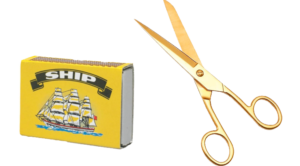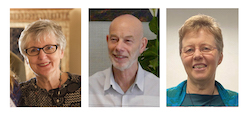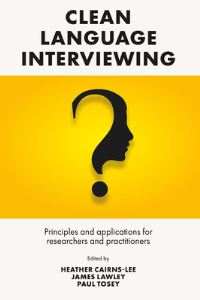I’ve just found this blog and practice activity from 4 August 2010 that hasn’t been published on our website before.
David Grove told the story of how (in 1998) he turned one of his insights about the nature of language into something that could be used practically:
I have no idea what the parts of speech are – nouns, pronouns, adjectives etc. – and every year I would get someone to try and teach me and I never could figure it out, but as part of that process I was looking up the word ‘adjective’ and found that one particular dictionary had the root which means to throw at or to lay to. So an adjective is a word which is thrown at a noun or laid to it. In that moment I realised that the conjoining of an adjective to a noun is not that stable. If the noun is thrown at or laid to, then I ought to be able to throw it back from whence it came, or I can fire it, I can lay it off, so that an adjective is not necessarily welded or riveted to that noun.[1]
Did you notice that David’s creative leap came about because he took the metaphor from the etymology literally?: ‘Adjective’ derives from the Latin verb adjicere, from ad- ‘toward’ + jacere ‘throw’.
For example in the statement “He’s a terrible boy” the adjective “terrible” has been thrown against the noun “boy”. David devised a clever “pulling back” question for releasing the noun from the tyranny of the adjective:[2]
And what kind of [noun] was that [noun] before it was [adjective]?
e.g. Facilitator: And what kind of ‘boy’ was that ‘boy’ before he was ‘terrible’?
Client: “A free spirit.”
A new metaphor appears which is not encumbered by the designation “terrible”. David was not saying that this in itself solved anything. It did however give the client a new and more productive ‘platform’ from which to continue. David warned that, “If you start exactly where that person wants you to start then you will be bound by those initial starting conditions.”
The adjective plays an important role. An adjective modifies, refines or qualifies the noun. This boy is no longer just a boy when he is a “terrible boy”. One way to notice the effect of a modifier is to remove it from the sentence and see what difference it makes. Compare “I have an awful sadness” with “I have a sadness”. The adjective “awful” invariably taints the noun “sadness”.
David’s second insight was that it is not just nouns that get qualified, so do pronouns. Let’s take “I am a bad person” as an example. Not only is the noun “person” afflicted with the adjective “bad”, the pronoun “I” is defined as “a bad person”. In everyday life these “characterological adjectives” can be devilishly hard to shake off.[3]
However, David could use much the same clean-question formulation as above to shake the qualifier off the pronoun:
And what kind of [pronoun] was that [pronoun[ before [pronoun] was [qualifier]?
e.g. And what kind of ‘I’ was that ‘I’ before ‘I’ was ‘a bad person’?
David experimented with several kinds of questions which all involved pulling back to a time or place before the one specified by the original statement.
Extending Grove's idea
Modifier and modified
While David’s first insight was about the relationship of adjectives to nouns and his second about the effect of qualifiers on pronouns, it soon became clear that there are lots of ways one part of speech can modify another part. Instead of trying to identify the particular grammatical names involved, I prefer to use the more generic terms of ‘modifier’ and ‘modified’ to indicate which part is doing what.
Examples of modifier and modified:
It is stuck tight.
“tight” modifies “stuck”
“It” is modified by “stuck tight”.I live in a pit of despair.
“despair” modifies “pit”.
“pit of despair” modifies “live”.
“live in a pit of despair” modifies “I”.I am heavily overweight.
“over” modifies “weight”
“heavily’ modifies “overweight”
“I” is modified by “heavily overweight”.
Thus a more generic formulation is:
And what kind of [modified] is/was that [modified] before it is/was [modifier]?
And where could [modified] be before it is/was [modifier]?
In reviewing David’s work I realised that in principle the modified could equally be freed of its modifier by jumping forward to after the time or place specified by the original statement:
And what kind of [modified] could that [modified] be after it is [modifier]?
And where could [modified] be after it is/was [modifier]?
The aim here is not to take a step forward as in “And then what happens?” since things are liable to go from bad to worse. The aim is to get to a time or place beyond the unwanted state. Few if any things stay the same forever which implies that mostly there will be a time after, when things are different. And this is all the more possible when we are speaking of mental constructs.
e.g. I live in a pit of despair.
And what kind of ‘pit’ was that ‘pit’ before it was ‘a pit of despair’?
And what kind of ‘pit’ could that ‘pit’ be after it is ‘a pit of despair’?
And what kind of ‘live’ is that ‘live’ before it is ‘in a pit’?
And what kind of ‘live’ could that ‘live’ be after it is ‘in a pit’?
And what kind of ‘I’ could that ‘I’ be before ‘I lives in a pit of despair’?
And what kind of ‘I’ is that ‘I’ after ‘I’ has ‘lived in a pit of despair’?
And where did ‘you live’ before ‘you lived in a pit of despair’?
And where could ‘you live’ after ‘you’ve lived in a pit of despair’?
As you can see, you may have to, as David would say, “finesse” the wording. That is, within the general structure of the question, you may need to shape the wording until it fits – it feels right to the client.
Whether you pull back or jump forward you may need to ask one or more of these questions a number of times until it is clear that the modified has separated from the original modifier.
Ways to separate a potential resource from a problem statement
While I was considering problem statements I remembered that often they contain a ‘hidden’ or ‘potential resource’. For example:
I have a very powerful resistance to change.
“resistance” modifies “change”
“powerful” modifies “resistance to change”
“very” modifies “powerful (resistance to change)”
“very powerful resistance to change” modifies “I”
It seems that “very powerful” is a calling the shots and therefore is a potential resource. It can be cleaved away from the rest of the problem statement simply by developing the attributes of the words “very powerful” or “powerful” or “power” and setting aside for the time being, the rest of the words in the sentence.
And what kind of [potential resource/desired outcome] is that/could that be?
e.g. And what kind of ‘powerful’ could that ‘powerful’ be?
Notes
1. David Grove at a ‘Conservation of Conversation’ workshop in London with Wendy Sullivan, 24-25 May 2006.
2. My first record of David using the ‘And what kind of X was that X before it was Y?’ formulation was at his retreat in Eldon, Missouri, USA in January 1999.
3. For more on characterological adjectives see Judith DeLozier’s article Mastery New Coding and Systemic-NLP, NLP World, Volume 2, No. 1, March 1995.
Practice exercise (advanced)
This activity was first trialed at London Clean Practice Group – 3 August 2010
Process for separating the modifier from the modified:
1. Client provides a problem statement.
Facilitator identifies modifier and modified in the statement.
2. To split the modified from the modifier ask something like:
And what kind of [modified] is/was that [modified] before it is/was [modifier]?
And what kind of [modified] could that [modified] be after it [modifier]?
And where could [modified] be before/after it is/was [modifier]?
You may need to ask one of these questions a number of times until it is clear than the modified is operating independent of the original modifier.
3. Develop the individuality of the modified until becomes attached to a new modifier and then develop that with:
And what kind of …?
And is there anything else about …?
And where is …?
And that’s … like what?
4. Then find out the effects on the original modifier, by asking:
And when [new modifier/modified] what happens to [original modifier]?
Remember, as the facilitator you are not trying to solve anything. Rather your aim is to invite the client to notice the original statement in a wider context, and then to revisit it from a different time-space – and see what happens.
Example
1.
C: I am impulsive.
2.
F: And what kind of ‘I’ was that ‘I’ before ‘I’ was ‘impulsive’?
C: I don’t know. I can’t remember a time I wasn’t impulsive.
F: And what kind of ‘I’ was that ‘I’ before ‘I couldn’t remember being impulsive’?
C: Formless
3.
F: And what kind of ‘formless’?
C: Two dimensional with swirls.
F: And is there anything else about that ‘formless, two dimensional with swirls’?
C: It pulses.
F: And what kind of ‘pulses’ are those ‘pulses’?
C: Like heart beats.
4.
F: And when ‘pulses’ are ‘like heart beats’ and ‘formless, two dimensional with swirls’, what happens to ‘impulsive’?
C: I like it
F: And then what happens?
C: When somebody says “you are impulsive” I shall say proudly “yes I am”.
Acknowledgement
As always, my heartfelt gratitude goes to David Grove and his quirky, insightful, mind-stretching ways of seeing the world!







